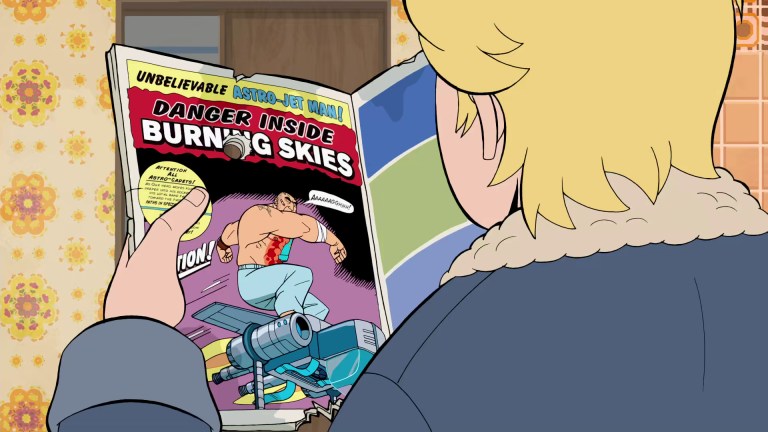How The Venture Bros. Helped Comic Book Tropes Evolve
The Venture Bros. deconstructed a lot of comic book stereotypes, but also proposed ways to help the medium grow.

There’s nothing new about comic book and superhero parodies. Many films within the current superhero cinema system like Deadpool even turn a self-aware eye to the source material, while shows like The Tick poke fun at the medium with exaggerated character types. A lot of the material that pokes fun at comics, however, does so for the simple joys of parody or to highlight the intrinsic silliness of superheroes. Adult Swim’s classic and now sadly-concluded animated series The Venture Bros. goes about things a bit differently.
The Venture Bros. didn’t begin as a direct analysis of the form and genre, but it gradually started to tell a story that used comic book tropes to show how dangerous and destructive superheroes can be and how they perpetuate a dysfunctional world. The Venture Bros. will gleefully indulge in parody, but it does so to highlight what’s wrong with these ideas and to help promote change. After the series’ recent cancellation, fans have been mourning The Venture Bros. for many reasons, but what’s unique about this series is how it uses informed parody to spotlight the flaws of comic book storytelling and then present a radical, better rounded alternative. Here are some of the best examples.
The Monetization and Crooked Nature of Superhero Leagues
When The Venture Bros. relocates its characters to New York City, they encounter the Crusaders Action League, their universe’s equivalent to the Justice League or the Avengers. The Crusaders Action League run a racket on the city and force civilians to pay them in exchange for their protection and bully those that don’t. Any outside heroes are treated like threats and the group runs a monopoly on crimefighting that’s not dissimilar to how a drug lord runs their corner. The Crusaders Action League is like a major corporation that tries to regulate the public’s safety into something that can be monetized to their advantage. DC and Marvel frequently depict the arguments that happen within their superhero supergroups, but The Venture Bros. evolves this idea to the point where they’ve completely stopped caring about keeping the peace and have turned the privilege of safety into an arrangement that many can’t afford.
The Uncomfortable Nature of “Boy Wonder” Sidekicks
It’s become low-hanging fruit at this point to make jokes about the relationship between Batman and Robin, but The Venture Bros. provokes this topic as a way to say something deep. The show’s Captain Sunshine is more like an amalgamation of both Batman and Superman, but the focus on the character is in regards to his young, boy partner. Hank finds himself in the role of Captain Sunshine’s latest Boy Wonder, which opens a whole discussion on not just the dynamic between Batman and Robin, but that the trauma that Batman experiences from losing so many partners should drive him insane. Captain Sunshine is depicted as highly unstable and he resorts to taking orphans for his new wards. DC often frames a new member of the Bat-Family as a can’t-miss event, but The Venture Bros. pinpoints how this constant loss is the sign of obsessive dysfunction.
A Family of Superheroes Would Never Be Able To Stay Together
The Venture Bros.’ Impossible family is a very clear lampoon of the Fantastic Four. Marvel props up the Fantastic Four as family and friends that have undergone incredible adversity together, but they’re able to use these changes to their advantage, and are made into famous public figures. In contrast, the members of the Impossible family are depicted as horrors of science more than a successful team of crimefighters. The show looks at the realistic pain associated with someone setting themselves on fire or what it means to turn invisible. The effects and aftermath of this accident is shown to fracture this family, not make it stronger. The series reaches the point where the family’s Reed Richards surrogate gets driven to Howard Hughes levels of paranoia, pushes his wife to infidelity, and leaves the parentage of his child in doubt. The idea of a crimefighting family is fun, but The Venture Bros. shows the dangers involved with familial pain and how this is a backstory more appropriate for villains than heroes.
Mystery Inc. Are Detached Maniacs Who Are Lost in Denial
Scooby-Doo and the other Hanna-Barbera creations from the 1960s often reflect a set of values that run parallel to the idealism and optimism of Silver Age Comics. Different takes on Scooby-Doo are self-aware to contrasting degrees, but The Venture Bros. is the first to frame them as legitimate dangers who need to be off the streets. The Groovy Gang finds ingenious similarities between the members of the Mystery Inc. with feared serial killers and maniacs like Ted Bundy, Son of Sam, Valerie Solanas, and Patty Hearst. The Shaggy surrogate even thinks that he can hear his dog talk to him, which is in itself another reference to David Berkowitz.
The show argues that the Groovy Gang doesn’t have any actual mysteries to solve and that they create more problems out of their delusions. They’ve managed to survive by looting the vicinities of their “mysteries” and they’ve been lost in this façade for over a decade. Scooby-Doo periodically puts its wholesome nature under the microscope, but The Venture Bros.’ Groovy Gang details the true progression of how a life in denial and arrested development can turn people into monsters.
Spider-Man and The Horrors of Animal-Based Superpowers
Comic books have a tendency to glamorize superpowers and highlight how incredible it would be to suddenly have the same talents as some kind of animal or insect like a cheetah, shark, or ant. The Venture Bros.’ Brown Widow applies a realistic and anatomically accurate take on Spider-Man and how much of a burden his set of skills would be. The superhero produces organic webbing, but from a spinneret near his anus that turns the power into more of an opportunity for embarrassment. Brown Widow also has six eyes, four of which he’s forced to hide underneath a headband for some attempt at normalcy. Brown Widow is constantly ashamed of his abilities and they speak to the disturbing body horror nature of animal-based superpowers in a way that’s more grounded than something like Marvel’s Man-Spider. Even the character’s name is meant to undercut any superpowers and utility with how it refers to the relatively benign nature of brown widow spiders.
Jonny Quest and The Inherent Sadness of Boy Adventurers
Comic books are supposed to create a feeling of excitement the same is true for series like Jonny Quest or The Hardy Boys that find ways to put eager youth into the roles of mystery-solvers. The Venture Bros. features an entire episode that’s devoted to a therapy session where former “boy adventurers” discuss the damage that these exploits have had on their adult lives. These characters emphasize that a life of adventure is actually a life of trauma and that any person who’s spent their life this would want to repress these memories rather than brag about them. Many of the different superheroes in The Venture Bros. highlight the dangerous ways that toxic expectations can warp the public, but this proves that this level of machismo in youth won’t prepare these adventurers for adulthood, but actually debilitate them.
The Opulent Absurdity of Latveria and Castle Doom
Comic books are ripe with megalomaniacal tyrants who aren’t just content to take over territories, but often want to create their own nations that are meant to act as monuments to their hubris. Doctor Doom and Latveria are the best examples and The Venture Bros. offers up its equivalency in the form of Baron Ünderbheit’s Ünderland. Doctor Doom is often exiled from his own home, yet he always manages to persevere and regain control. In the case of Ünderland, the nation actually prospers after Ünderbheit is kicked out and it becomes a successful democratic nation in his absence. Ünderbheit floats around and struggles to find a purpose. This whole relationship depicts a realistic look at how a ruler can become irrelevant and that nations often outgrow their original purpose. It’d be like if Latveria turned into Wakanda.
The Uselessness of Elaborate Supervillain Schemes
One of The Venture Bros.’ more brilliant ideas is to take established villain tropes and then combine them all into members of Andy Warhol’s entourage like Edie Sedgwick, Brigid Berlin, and Paul Morrissey in order to say something bigger on the convoluted nature of villainy. The Doom Factory is a commentary on the largely conceptual ideas of supervillain teams that go way overboard for what could be a lot easier. The Venture Bros. pushes this to an absurd degree where villainy schemes are more akin to art installations and “happenings” where the victims are more confused than distressed. This attitude results in The Doom Factory’s quick death as they employ a realistic approach to a team that is more about status and appearances than actual villainy. The villains in the Legion of Doom or other similar groups can sometimes come across more like high-concept nuisances than threats against justice.
The Internalized Masculinity of G.I. Joe and Action Figures
Something very interesting within The Venture Bros. is how the majority of the most masculine characters are shown to be the ones with the most dysfunctions. The O.S.I. is the series’ parody of G.I. Joe and while it gets in its jokes about G.I. Joe’s ridiculous characters and their nicknames, it also digs much deeper than that. It takes this idea of character stereotypes to the extreme with how it basically turns the O.S.I. into a flamboyant Village People-like organization. However, The Venture Bros. doesn’t lean in this direction as a way to insult the characters, but instead it portrays them as some of the most competent individuals in the series. It says that a group like this who are open, proud, and different would do a better job than rote military grunts. G.I. Joe and Cobra Command remain locked in irreconcilable conflict due to their stereotypical aggression and testosterone, but in The Venture Bros. these iconoclastic personalities can unite the two and form a stronger entity in the process.
Constant Cosmic Threats From The Future
Comics have frequently featured grand cosmic characters that are meant to observe events and pass judgment on the universe with the power to end the whole thing if they see fit. The Venture Bros. beautifully flips this idea on its ear in every possible way in “Twenty Years to Midnight.” A very Jack Kirby-like celestial being known as The Grand Galactic Inquisitor arrives with a purpose that’s nearly identical to that of the Living Tribunal (with a bit of The Watcher thrown in for good measure, too). The entire episode has the Grand Galactic Inquisitor build up dire stakes, only for the character to be shot in the head and swiftly handled. Comic books can get so lost in these cosmic threats from the future and their emphatic vastness, but The Venture Bros. addresses how ridiculous it all is by how it neutralizes the threat before it can actually do anything. There are more than enough problems on the Earth, in the present, to worry about.
